Hypoglycemic natural products with in vivo activities and their mechanisms: a review
Wenyi M Longgao Xiao, Haiyang Liu*, Xiaojiang Hao*
a State Key Laboratory of Phytochemistry and Plant Resources in West China, Yunnan Key Laboratory of Natural Medicinal Chemistry, Kunming Institute of Botany, Chinese Academy of Sciences, Kunming 650201, China
b University of Chinese Academy of Sciences, Beijing 100049, China
Keywords:
Diabetes
Natural products
Hypoglycemic effects
Mechanism
A B S T R A C T
Diabetes mellitus (DM) is a metabolic disorder disease, and the number of diabetic patients will reach 578 million by 2030 predictably. Currently, 8 classes of small molecular drugs are used for treating diabetes.However, these drugs cannot completely meet patients’ needs, due to diabetic complications need to be addressed along with diabetes, such as nephropathy, and cardiovascular diseases. Besides, more types of drugs need to be provided for more choices. Hence, scientists still seek lead compounds with hypoglycemic effects. Natural products (NPs) are a reservoir of diverse structures and bioactivities with low toxicity and less side effects. And some of them show effects on diabetic complications, which is a significant idea for drug development. This review aims to summarize natural products with hypoglycemic effects and their details, such as potential mechanisms, biological data, and particularly their advantages in treating diabetes.Considering the huge number of NPs was reported with anti-diabetic activity, and some of them need to be re-validated, this review focuses on the bioactive compounds with in vivo activities. In the end, the trend of natural products treating diabetes was discussed. We hope this review provide a comprehensive and convincing summary, thus lending support to anti-diabetic natural products research.
1. Introduction
Diabetes mellitus (DM), usually called diabetes, is a kind of metabolic disorder disease characterized by hyperglycemia. The symptoms are various among different stages and patients, but some signs may alarm diabetes, such as unexplained weight loss, frequent fatigue, and repeated infectious in the genital areas or urinary tracts [1].In addition, diabetes may induce a series of complications, such as diabetic ketoacidosis (DKA), cardiovascular disease, chronic kidney disease, and hyperosmolar hyperglycemic state, causing patients to great suffering [2]. According to ‘International Diabetes Federation’,it is estimated that diabetes patients will rise to 10.2% (578 million)by 2030 and 10.9% (700 million) by 2045 [3]. According to the recent 2021 American Diabetes Association “Standards of Medical Care in Diabetes, diabetes can be classified into 4 types [4]:1) Type 1 diabetes, which may occur in both children and adults.The pathogenesis is mainly due to inheritance or immune system deficiency, which lead to insulin efficiency. And patients need to inject insulin lifelong; 2) Type 2 diabetes is usually caused by insulin resistance, which is associated with inheritance, overweight,or exercise deficiency. The number of patients with type 2 diabetes accounts for 90%-95% among all diabetes patients; 3) Specific types of diabetes due to other causes, such as monogenic diabetes, diseases of the exocrine pancreas, and drug- or chemical-induced diabetes;4) Gestational diabetes mellitus, which refers diabetes are diagnosed in the second or third trimester of pregnancy.
Current available therapeutical drugs with small molecules for diabetes, such as metformin, canagliflozin, gliclazide, acarbose, and sitagliptin, are classified into 8 categories according to their mechanisms(Table 1). Although most of these 8 types of drugs are synthetic drugs, natural products have made great contributions to drug research and development for a long time. On the one hand, some Chinese medicine formulae has been used to treat diabetes since ancient times and provides inspiration for modern anti-diabetic drug research. For example, “Gegen Qinlian Decoction” which recorded in “Treatise on Febrile Diseases (Shanghanlun)” by Zhongjing Zhang, includingPueraria montana,Scutellaria baicalensis,Coptis chinensis, andGlycyrrhiza uralensis, was used as folk remedy for treating diabetes [5].Scientists now find that the potential bioactive components areflavonoids, isoflavonoids, alkaloids, and so on, which furnish fresh ideas for hypoglycemic drugs research and development [6].On the other hand, natural products are an important source of lead compounds and drugs and they have provided inspiration for drug design due to their diversity structures and attractive bioactivities [7]. It is noteworthy that the lead compounds of some crucial diabetic drugs are derived from natural products. The most well-known are metformin and gliflozin and their derivatives.
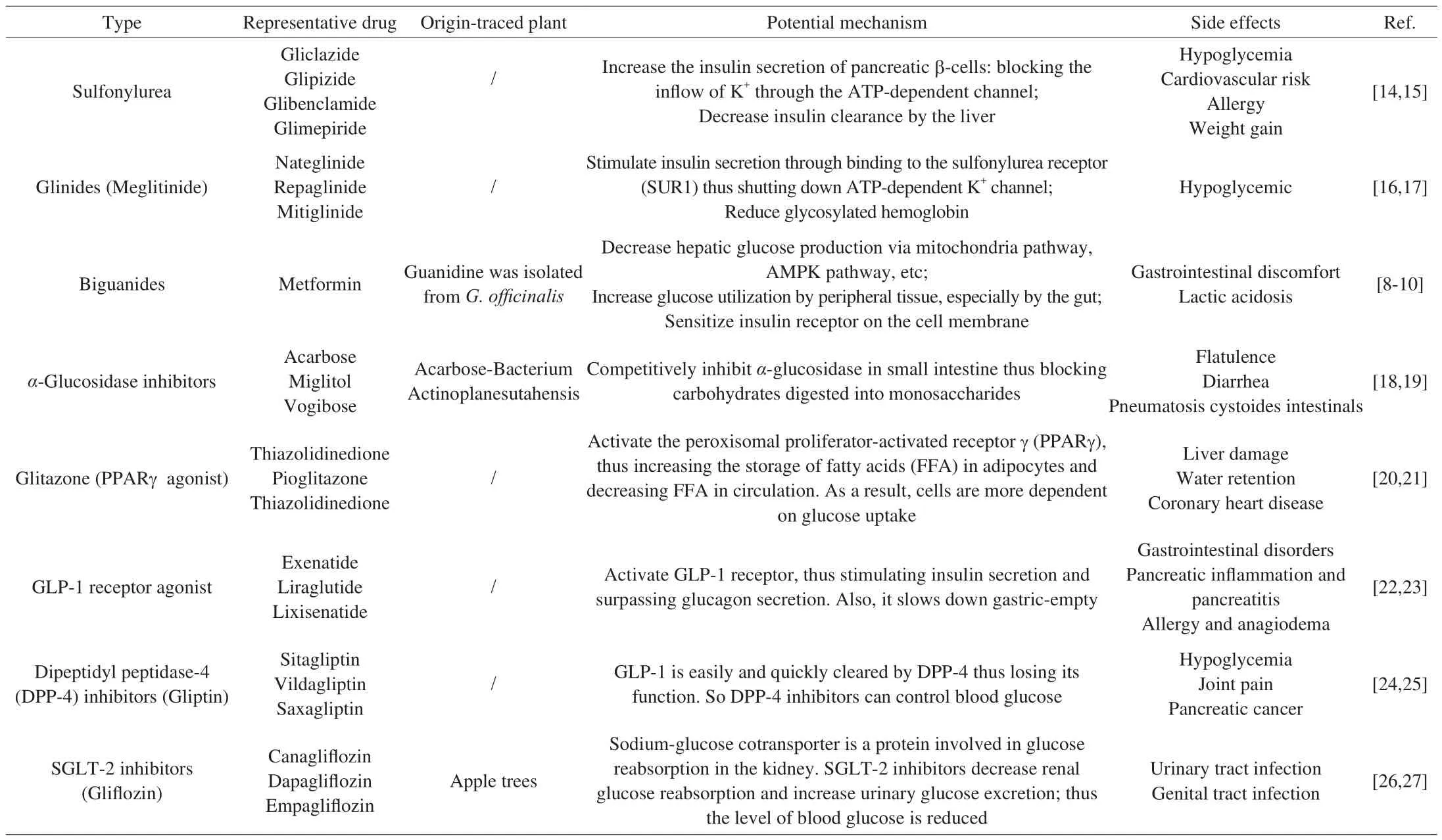
Table 1Different kind of drugs for type 2 diabetes on market.
The history of metformin can be traced from medieval Europe,people usedGalega officinalis(also called goat’s rue) to treat hyper diuresis, a French scientist found that the active component ofG. officinalisis guanidine [8]. In the following decades, a bunch of derivatives of guanidine was synthesized and metformin showed a staggering perspective because of its high efficacy on hyperglycemia.However, they did not attract people’s attention because of the prevalent usage of insulin. Until the 1940s, scientists occasionally found metformin not only shown hypoglycemic effects, but also improved insulin sensitivity when they used it as the anti-malarial drug. Thus metformin returned to people’s sight. In 1994, it was approved by FDA and introduced in the US market in 1995. The detailed research & development history of metformin is depicted in Fig. 1a. The mechanism of metformin cannot be defined, however,scientists now hold the opinion that metformin plays its role via decreasing hepatic gluconeogenesis through mitochondrial pathway and increasing glucose uptake through AMPK pathway [9]. Besides,metformin may modulate glucagon-like peptide-1 (GLP-1) secretion and glucose utilization via microbiome modification in GI tract [10].In summary, it is a complex drug with multiple sites of action and mode of action which need deeper research.
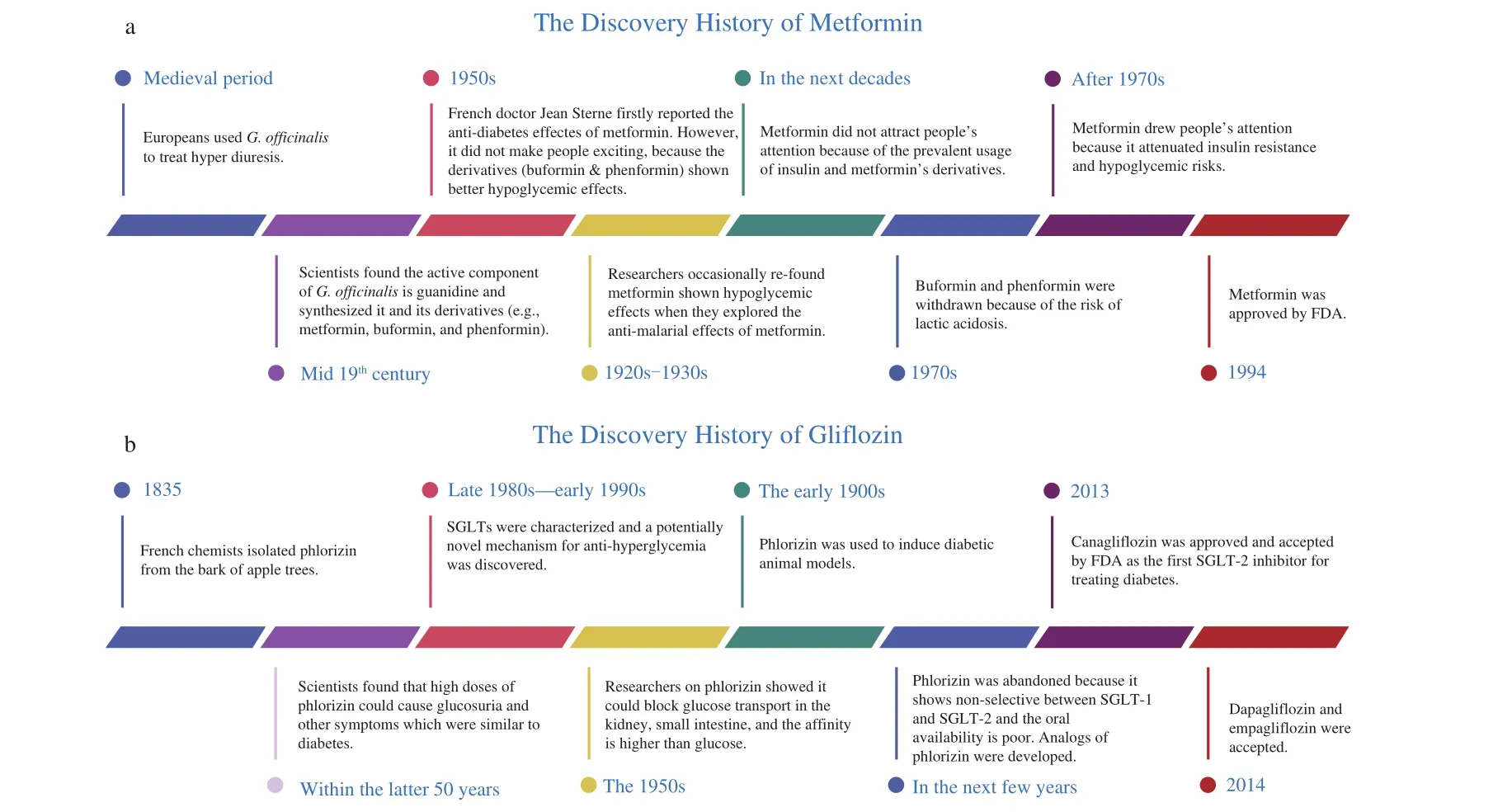
Fig. 1 The research & development history. (a) Metformin, (b) Gliflozin.
Gliflozin, a type 2 diabetes medication, shows hypoglycemic effects via inhibiting sodium-glucose cotransporter-2 (SGLT-2)and preventing kidneys from reabsorbing glucose thus lowering blood glucose and promoting the excretion of glucose in the urine.In 1835, French chemists isolated phlorizin from the bark of apple trees. Within the latter 50 years, scientists found that high doses of phlorizin caused glucosuria which was similar to diabetes. Thus, in the early 1900s, it was used to induce diabetic animal models. In the 1950s, researchers on phlorizin showed that it could block glucose transport in the kidney, small intestine, and a few other tissues, and the affinity is even higher than glucose. In the late 1980s to early 1990s, SGLTs were characterized and a potential novel mechanism for anti-hyperglycemia was discovered. However, phlorizin was not eventually developed as a new drug for diabetes, because it shows non-selective between SGLT-1 and SGLT-2 and the oral availability is poor. Analogs of phlorizin have been developed in the later decades. In 2013, canagliflozin was approved and accepted by FDA as the first SGLT-2 inhibitor for treating diabetes. In 2014, dapagliflozin and empagliflozin were accepted [11-13](Fig. 1b).
Besides, there are other 6 types of drugs on the market for treating diabetes (mainly type 2 diabetes) according to their mechanisms.Details about all these 8 kinds of drugs are summarized in Table 1.
Although many targets, mechanisms, and drugs for treating diabetes have been discovered, they still cannot perfectly meet patients’ needs. Because some drugs have serious side effects while others exert poor patient compliance. In recent years, scientists aim to find natural products with hypoglycemic effects to facilitate research and development of diabetic drugs. Fortunately, some compounds show perspective anti-diabetic activities, and structures as well as mechanisms are diverse. However, the majority of bioactivity experiments are testedin vitro, which may not suitable for animal models and patients. In this review, we filtrate out natural products within vivohypoglycemic effects and summarize their sources,potential mechanism, biological data, etc. We hope this review can lend informative support to discover lead compounds or new drugs for treating diabetes mellitus.
2. Hyperglycemic natural products
According to their chemical structures, we thoroughly classify the hyperglycemic natural products into the following general categories:terpenoids, alkaloids, flavonoids, polysaccharides, and other types.Among all types of natural products, terpenoids with hypoglycemic effects account for approximately one half (Fig. 2). In each section,names, types, potential mechanisms, animal models, biological data,sources, pharmaceutical parts, and structures of antidiabetic natural products are discussed in detail.
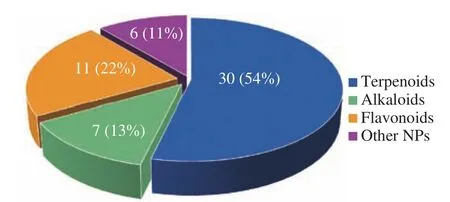
Fig. 2 Different natural products (NPs) with hypoglycemic effects and their proportion.
2.1 Terpenoids
Terpenoids are a class of natural products formed by the polymerization of multiple isoprene and derivatives as structural units.According to the number of isoprene structural units in the structures,terpenoids can be divided into monoterpenes, sesquiterpenes,diterpenes, sesterterpenes, and triterpenes, etc. In plants, terpenoids are important defense or communication substances [28]. Besides, as pharmaceutical agents, some terpenoids are developed as drugs on the market, such as artemisinin (sesterpene), paclitaxel (diterpene),andrographolide (diterpene), and glycyrrhizic acid (triterpene).Recently, the anti-diabetic effects attract researchers’ attention,especially ginsenosides inPanax ginseng.
2.1.1 Ginsenosides
P. ginseng(Araliaceae) is one of the most popular herbal remedies known for its function of improving memory and weakness, reducing fatigue, etc. A bunch of drugs containingP. ginsengis on the markets,such as Ginseng Tablet (treat feebleness inappetence), Ginseng Stem and Leaf Total Saponins Tablets (adjuvant treatment for coronary diseases, menopausal syndrome, and tumors). Researchers found that ginsenosides are the main bioactive components of ginseng.According to their structures, ginsenosides are dammarane-type tetracyclic triterpenoids and can be classified into two categories: the first class is protopanaxadiol (PPD), such as compound K (CK, 1),ginsenoside Rh2, Rg5, Rb1, Rb2, and Rb3. And the second class is protopanaxatriol (PPT), such as ginsenosides Rg1, Rk3, and Re.
CK is becoming the fast focus of hypoglycemic compounds. CK is absent from natural ginseng but can be transformed from other ginsenosides such as Rb1 and Rb2 via biotransformation [29]. CK is a major metabolite found in human organs or blood after oral administration of PPD [30]. Compared with other ginsenosides,the solubility and efficacy of CK are better, thus its bioactivity is better. Insulin secretion is important for sustain a well-balanced glucose level. A study showed that oral CK administration stimulating insulin secretion associated with ATP-sensitive K+channel open indb/dbmice. Compared with the control group, CK-treated groups(12.5 and 25 mg/kg dose) showed a 9% and 15% reduction of blood glucose level, respectively and the plasma insulin level increased [31]. Besides, CK also protected islet cells from apoptosis through inhibition of the AMPK/JNK pathway in T2D mice [32].Furthermore, the management of gluconeogenesis is essential for treating diabetes. In this line, CK was found to be able to suppress hepatic gluconeogenesis through increasing activation of AMPK pathway in STZ-induced diabetic mice [33]. In another study, insulin sensitivity could be improved by CK, which is associated with PI3k/Akt signaling pathway [34].
Furthermore, CK has protective effect on diabetic nephropathy (DN).DN is a serious kidney-related diabetic complications, which is characterized by the presence of urine albumin excretion, the decreasing of glomerular filtration rate (GFR), and the damage of glomerular [35]. Besides, DN has become one of the most common cause of end-stage renal disease and its treatment is more complicated compared with other kidney diseases [36]. Jiang’s lab [37]found that CK show positive effect on diabetic nephropathy via inhibiting the oxidative stress, NLRP3 inflammasome and NF-κB/p38 signaling pathway. The experiment was tested on HFD/STZ-induced diabetic mice, and CK was intragastrically administrated for 8 weeks. The results showed that blood glucose, blood urea nitrogen, as well as urine protein decreased, which suggested that CK not only alleviated blood glucose level, but also had the potential to attenuate diabetic nephropathy.
Other ginsenosides with hypoglycemic effects are also listed in the Table 2 and their structures are depicted in Fig. 3.
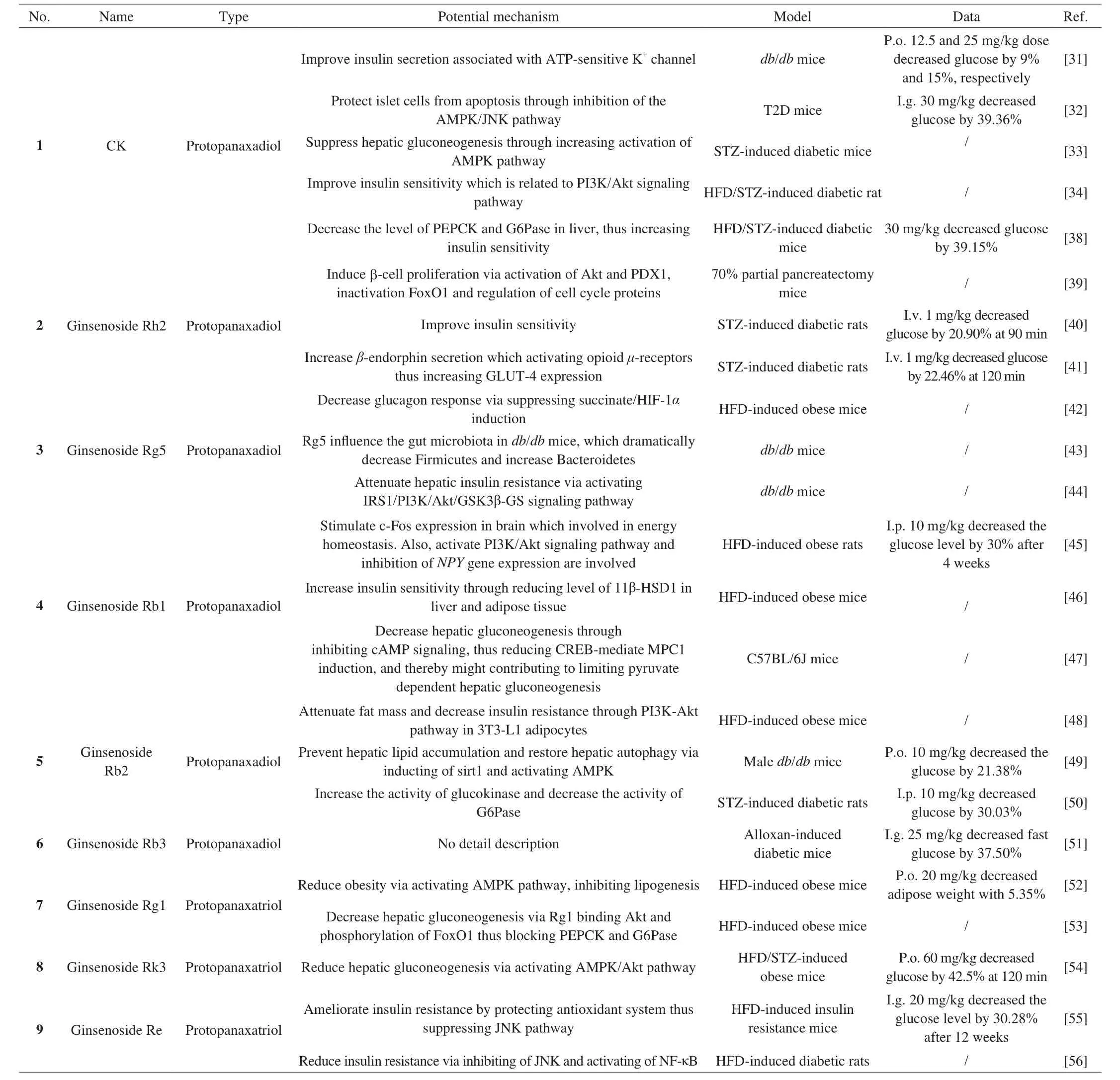
Table 2Ginsenosides with hypoglycemic effects.

Fig. 3 Structures of ginsenosides with hypoglycemic effects.
2.1.2 Other terpenoids
Apart from ginseng, several other traditional herbs also containing rich terpenoids, such as oleanolic acid (OA), an oleanolic-type triterpenoid, exists in the whole herb ofSwertia mileensisand fruits ofLigustrum lucidum. Previous research of oleanolic acid and its hepatoprotective effect has achieved great success and scientists have developed oleanolic acid tablets. Recently, the anti-diabetic effects of OA have attracted people’s attention. One possible mechanism related to the liver is OA shows antioxidant effects, thus protecting the liver and kidney and decreasing blood glucose. Intragastric administration of OA (100 mg/kg decreased the blood glucose by 58.18% at day 40 in alloxan-induced diabetic rats [57]. Besides, OA stimulates insulin secretion, thus decreasing blood glucose level and modulation lipid metabolism in STZ-induced diabetic mice [58].
Cardiovascular disease (CVD) is another severe complication of type 2 diabetes, which includes coronary heart disease, atherosclerosis,cardiac hypertrophy, and hypertension [59]. OA was proved that it could attenuate risk factors of CVDs in diet-induced pre-diabetic rats via decreasing dyslipidaemia, oxidative stress, hypertension, and low-grade inflammation [60]. Besides, OA also exhibit positive effect on diabetic nephropathy, and the potential mechanism is related with reducing of oxidative stress and endoplasmic reticulum stress in T2 diabetic rats [61].
Other research aims at mechanisms of active terpenoids at the animal level, such as bassic acid (11) fromBumelia sartorum, and cyclocaric acid B (12) fromCyclocarya paliurus, are listed in Table 3 and Fig. 4.

Table 3Terpenoids with hypoglycemic effects.

Fig. 4 Structures of terpenoids with hypoglycemic effects.
2.2 Alkaloids
Alkaloids are significant secondary metabolites produced by plants in response to environment modulations. As pharmaceutical agents, alkaloids extend various biological activities, such as antiinflammation, anticancer, antibacterial activities [80]. These properties also attract scientists to explore its antihyperglycemic effects.
Berberine (31), isolated from rhizomes ofC. chinensisFranch.,a representative isoquinoline alkaloid treating diabetes and inflammation in traditional Chinese herb [81]. Recent studies reveal that it shows significant antihyperglycemic effects.Berberine increases insulin sensitivity via up-regulating insulin receptor (IR) expressing with activation of protein kinase C(PKC) promoter. And the level of blood glucose decreased by 22% and 33% in oral administrated berberine (75 and 150 mg/kg,respectively) STZ-induced diabetic rats after 15 days [82]. Besides,berberine is characterized as an AMPK activator, which improves fatty liver in obesedb/dbmice mediated by central and peripheral AMPK activation [83]. The direct and definite antihyperglycemic mechanism of berberine is still under exploring.
Furthermore, berberine shows significant perspective in treating diabetic complications. Diabetic osteoporosis is caused by the deficiency of calcium and phosphorus due to lack of insulin and some hormone or endocrine. Sun’s lab found that berberine alleviated bone loss in diabetic osteoporosis via lowering DNA damage oxidation and up-regulating serum antioxidation activity [84].Besides, berberine also show positive effect on other diabetic complications, such as endothelial and cardiovascular diseases,nephropathy, and neuropathy [85].
Other alkaloids with hypoglycemic bioactivity, including glycosine (33), evodiamine (34), trigonelline (35), etc., are summarized in Table 4 and their structures are described in Fig. 5.

Table 4Alkaloids with hypoglycemic effects.
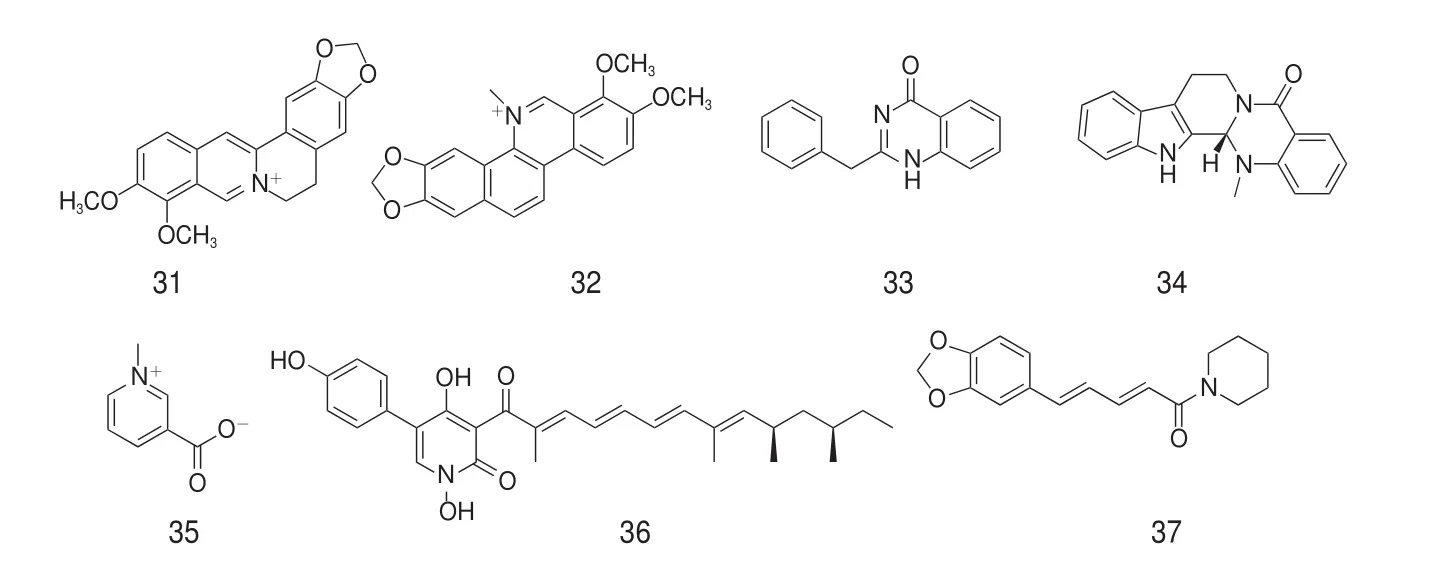
Fig. 5 Structures of alkaloids with hypoglycemic effects.
2.3 Flavonoids
Flavonoids are distributed in a variety of fruits and vegetables,which exist broad health-promoting effects, such as antioxidative,anti-inflammatory, anticancer and antimutagenic bioactivities [92].
Gingko biloba, is native to China, has a bunch of clinical usage, such as improve blood circulation, reinforce capillaries walls and prevent oxidation [93]. In recent years, anti-diabetes effects of flavonoids in gingko have attracted researchers’attention. Kaempferol (38), isolated from leaves ofG. biloba,ameliorate blood glucose in diet-induced obese mice. The mechanism is associated with decreasing hepatic gluconeogenesis and increasing hepatic insulin sensitivity via improving Akt and hexokinase activity and suppressing pyruvate carboxylase (PC)and G6Pase activity [94].
Other anti-hyperglycemic activities of flavonoids, and their detail information is listed in Table 5. Also, their structures are depicted in Fig. 6.

Fig. 6 Structures of flavonoids with hypoglycemic effects.
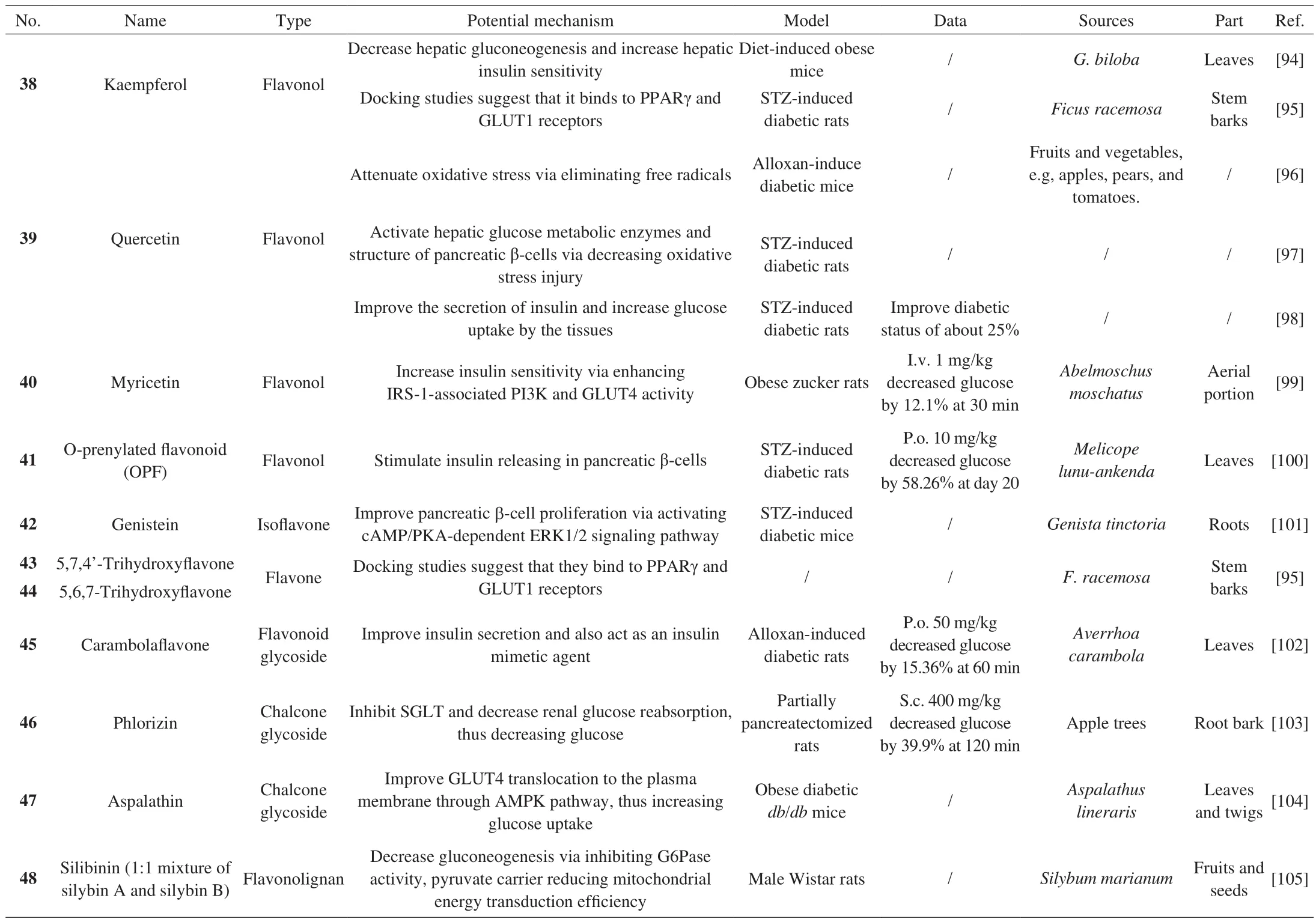
Table 5Flavonoids with hypoglycemic effects.
2.4 Polysaccharide
Polysaccharides are a long polymeric chain of monosaccharides that are linked by glycosidic linkages. Their functions in plants can be divided into 2 sections: storage energy (e.g., starch and glycogen)and protection (e.g., cellulose and hemicellulose). Polysaccharides also exhibit a bunch of therapeutical activities, such as anti-diabetic,immunostimulating, and antioxidant effects [106,107]. Among these bioactivities, the hypoglycemic function of polysaccharides is the most attractive.
Ganoderma lucidum, also called Lingzhi or Reishi, has been used for longevity and health promotion in ancient times.Modern medicine reveals thatG. lucidumpolysaccharides (GLPs)extend a variety of bioactivities, such as antioxidant, anticancer,anti-inflammatory, antimicrobial and hypoglycemic effects [108,109].Up to now, many anti-hyperglycemic mechanisms of GLPs have been studied. Pancreatic β-cells releasing insulin is very important for blood glucose balance. In this line, GLPs promote Ca2+to pancreatic β-cells thus increasing insulin-releasing [110]. Besides, GLPs and metformin combinatorial therapy ameliorates blood glucose in STZ-induced diabetic rats. The potential mechanism is GLPs protect β-cells via preventing apoptosis and enhancing regeneration of β-cells [111]. Excess gluconeogenesis lends more burdens to diabetic patients’ health. Research disclosed that GLPs decreased mRNA expression of several key enzymes, including glycogen phosphorylase(GP), fructose-1,6-bisphosphatase (FBPase), phosphoenolpyruvate carboxykinase (PEPCK), and glucose-6-phosphatase (G6Pase). These enzymes contribute to gluconeogenesis and glycogenolysis [112].Also, GLPs attenuate insulin resistance via AMPK activation and decreasing epididymal fat/BW ratio [113].
Polysaccharides in other plants and fungi also have hypoglycemic effects, such as polysaccharides inGrifola frondosa,Opuntia monacanthacladode,Lycium barbarumL. andSaccharina japonica[114-117]. However, most of them are polymers, whose structure cannot be elucidated. So anti-hyperglycemic polysaccharides are not summarized.
2.5 Other natural products with hypoglycemic effects
Apart from the NPs mentioned above, some other NPs also exhibit anti-diabetic effects. Curcumin (49), a diarylheotanoid isolated fromCurcuma longaL., has hypoglycemic effects. The mechanism may associate with anti-oxidation and anti-inflammation [118].
Besides, research on emodin (50), a quinone-type natural product isolated from a famous Chinese remedy Dahuang (Rheum palmatum),is quite interesting. Liu’s study [119]showed that emodin extended its hypoglycemic activity through activation of PPARγ in HFD and STZ-induced diabetic mice. Similarly, Yang’s study revealed that emodin up-regulated the phosphorylation of PI3K/Akt in KKAy mice,thus improved glucose uptake and decreased blood glucose level [120].However, a study in HFD obese mice suggested that the glucose-lowering effect of emodin is due to a spoilt appetite, without any other mechanism [121]. It is worth figuring out which mechanism plays a major role in the blood-glucose-lowering effect of emodin.
Moreover, Xie’s lab found that gordonoside F (51), a pregnanetype steroidal glycoside isolated fromHoodia gordonii, specifically activates GPR119 [122]. And the GPR119 receptor is predominantly expressed in the pancreas β-cells and enteroendocrine. The activation of GPR119 can increase the secretion of insulin and GLP-1 in the pancreas and GI tract, respectively, thus decreasing blood glucose [123].Besides, sterols perform well in anti-diabetic activities.Blazein (52), isolated from stems ofCucurbita moschata, shows insulin-like activities mediated by AMPK pathway in STZ-induced diabetic mice [124]. Moreover,β-ecdysterone (53) isolated fromCyanotis arachnoidea, while ergosterol (54) isolated fromPleurotus Ostreatus, show anti-diabetic effects in KKAy mice [125,126]. Their structures are depicted in Fig. 7.

Fig. 7 Structures of other NPs with hypoglycemic effects.
3. Conclusion and discussion
International Diabetes Federation predict that the proportion of diabetes patient will rise to 10.2% by 2030 [3]. Complication of diabetes torture patients, such as cardiovascular diseases,nephropathy, and osteoporosis. Unfortunately, current drugs cannot completely solve patients’ suffering.
Nature is a reservoir of various and unpredicted natural products which provide new bioactivities and mechanisms for some diseases.However, NPs still remain certain problems: most bioactivity data stagnate in cell or tissue (in vitro) level, andin vivoexperiments are absence. Besides, the mechanisms of natural products are not clear which is impeditive for research and development of lead compound and drugs. Also, some analysis of drug abilities such as the ADMET properties of some NPs are failed to meet standard, which need modifications. These obstacles need to be solved in the future.
In this paper, we mainly cover terpenoids, alkaloids, flavonoids,and other types of NPs which exhibitin vivohypoglycemic effects.Also, we summarized 54 natural products and their mechanisms,bioactivity data, origin plant and pharmaceutical data. All mechanisms can be classified into 6 classes (Fig. 8). Most NPs play their role via improving insulin secretion and insulin sensitivity. Besides, only two compounds areα-glucosidase or SGLT inhibitor. Other mechanisms such as antioxidant and anti-inflammation, decreasing lipid accumulation, and insulin mimetic agents, also play important roles.Two compounds (33 and 44) were predicted their targeted proteins in silico which were not listed in Fig. 8.
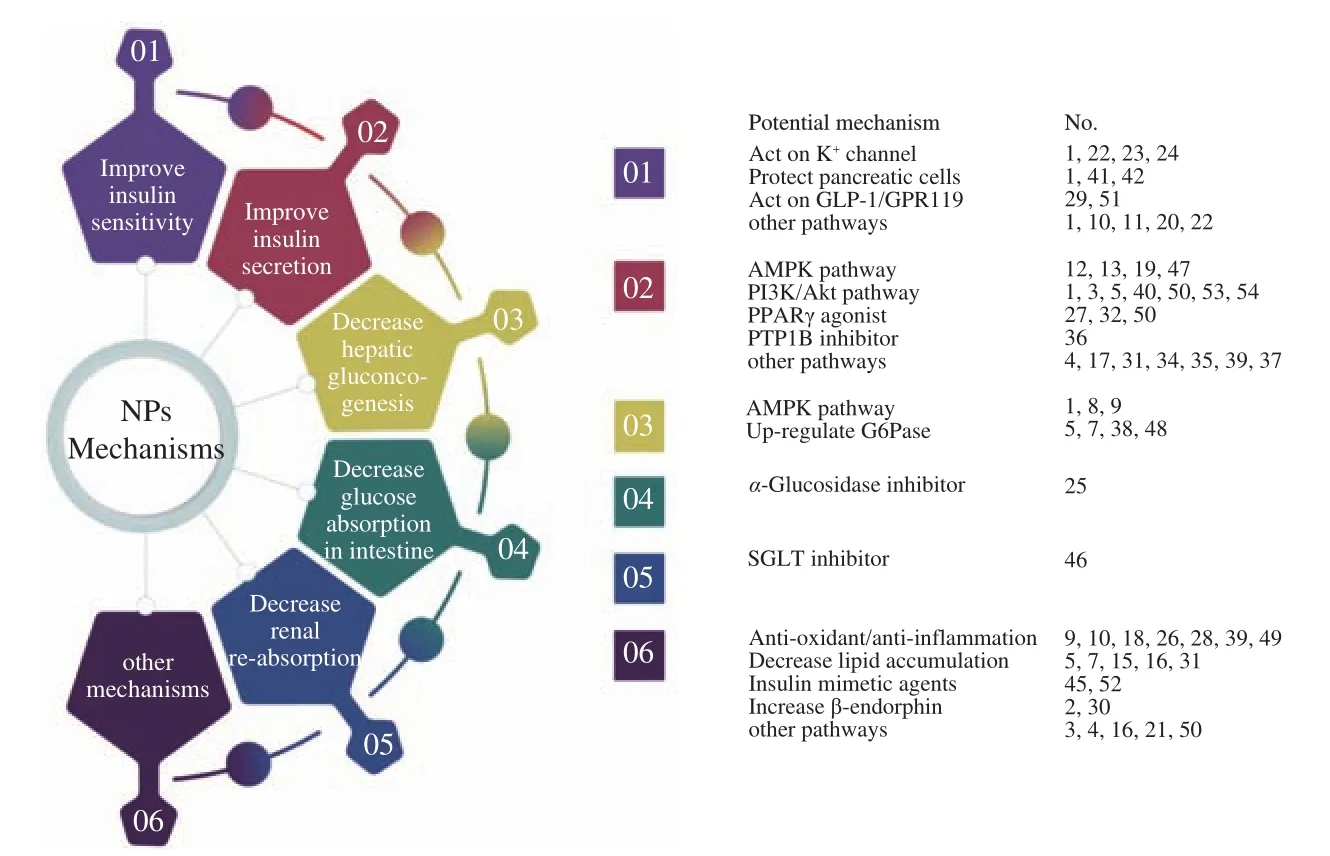
Fig. 8 Six kinds of mechanisms of NPs with anti-diabetic effects.
Above all, this review extends useful and well-organized information for further research and application of NPs to treat diabetes.
Declaration of interest statement
All authors declared they have no conflict.
Acknowledgements
This work was financially supported by the Natural Science Foundation of China (U1802287, 32000280, and 31770391) and Ten Thousand Talents Plan of Yunnan Province for Industrial Technology Leading Talents.
- 食品科学与人类健康(英文)的其它文章
- Bacteroides utilization for dietary polysaccharides and their beneficial effects on gut health
- Capsular polysaccarides of probiotics and their immunomodulatory roles
- Natural compounds may contribute in preventing SARS-CoV-2 infection: a narrative review
- A comprehensive review on the effects of green tea and its components on the immune function
- A review on current and future advancements for commercialized microalgae species
- Effects of silkworm pupa protein on apoptosis and energy metabolism in human colon cancer DLD-1 cells

